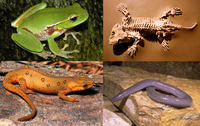
Ancient DNA analysis reveals temporal and geographical patterns of mitochondrial diversity in pre‐Hispanic populations from Central Argentina
Sign Up to like & getrecommendations! Published in 2022 at "American Journal of Human Biology"
DOI: 10.1002/ajhb.23733
Abstract: The study of the ancient populations of Central Argentina has a crucial importance for our understanding of the evolutionary processes in the Southern Cone of South America, given its geographic position as a crossroads. Therefore,… read more here.
Keywords: ancient dna; geographical patterns; dna analysis; temporal geographical ... See more keywords

Effects of long-term seed storage on germination of 13 cactus species from central Argentina
Sign Up to like & getrecommendations! Published in 2021 at "Journal of Arid Environments"
DOI: 10.1016/j.jaridenv.2020.104382
Abstract: Abstract Understanding the effects of long-term seed storage on germination is important to elucidate both soil seed bank dynamics and capacity of seeds to be preserved in ex situ conservation programs. We collected seeds 13… read more here.
Keywords: seed; term; germination; species central ... See more keywords

Petrographic characterization and identification of temper sources in local ceramics during the Inca domination and early Spanish colony (Mendoza, west-central Argentina)
Sign Up to like & getrecommendations! Published in 2017 at "Journal of Archaeological Science: Reports"
DOI: 10.1016/j.jasrep.2017.04.011
Abstract: Abstract This work relies on the potential use of petrography to determine temper provenance and applies it to ceramics of west-central Argentina. Petrography is used to identify the raw materials, production technologies and, for the… read more here.
Keywords: spanish colony; west central; early spanish; mendoza ... See more keywords

Age and growth in an anuran hybrid zone: Fitness-related traits of the diploid/polyploid ground frog complex (genus Odontophrynus) from central Argentina
Sign Up to like & getrecommendations! Published in 2021 at "Zoologischer Anzeiger"
DOI: 10.1016/j.jcz.2021.07.001
Abstract: Abstract Diploid Odontophrynus cordobae and tetraploid Odontophrynus americanus coexist in syntopy in central Argentina, and recently a hybrid zone between them with numerous triploid individuals has been reported. Furthermore, hybrid polyploids with odd numbers of… read more here.
Keywords: central argentina; growth; fitness; age ... See more keywords

A new echimyid genus (Rodentia, Caviomorpha) in Central Argentina: uncovered diversity of a Brazilian group of mammals in the Pleistocene
Sign Up to like & getrecommendations! Published in 2019 at "Journal of Paleontology"
DOI: 10.1017/jpa.2019.73
Abstract: Abstract. We describe a new extinct spiny rat, Proclinodontomys dondasi n. gen. n. sp. (Rodentia, Caviomorpha, Echimyidae), represented by a noteworthy preserved skull and mandible from the early-middle Pleistocene outcrops at the coastal cliffs of… read more here.
Keywords: rodentia caviomorpha; central argentina; genus; new echimyid ... See more keywords

A Pleistocene freshwater ichthyofaunal assemblage from central Argentina: What kind of fishes lived in the Pampean lagoons before the extinction of the megafauna?
Sign Up to like & getrecommendations! Published in 2020 at "PLoS ONE"
DOI: 10.1371/journal.pone.0235196
Abstract: This study contributes to the knowledge of continental fishes recovered from sedimentary successions corresponding to the Bonaerean Stage/Age (late mid-Pleistocene) in the locality of Centinela del Mar, General Alvarado County, Buenos Aires province, Argentina. At… read more here.
Keywords: freshwater ichthyofaunal; pleistocene freshwater; pleistocene; ichthyofaunal assemblage ... See more keywords

Acute and chronic HBV infection in central Argentina: High frequency of sub-genotype F1b, low detection of clinically relevant mutations and first evidence of HDV
Sign Up to like & getrecommendations! Published in 2023 at "Frontiers in Medicine"
DOI: 10.3389/fmed.2022.1057194
Abstract: Introduction Genomic analysis of hepatitis B virus (HBV) identifies phylogenetic variants, which may lead to distinct biological and clinical behaviors. The satellite hepatitis D virus (HDV) may also influence clinical outcomes in patients with hepatitis… read more here.
Keywords: hbv; clinically relevant; f1b; relevant mutations ... See more keywords

Wolf spider burrows from a modern saline sandflat in central Argentina: morphology, taphonomy and recognition of fossil examples
Sign Up to like & getrecommendations! Published in 2018 at "PeerJ"
DOI: 10.7287/peerj.preprints.26674v1
Abstract: Pavocosa sp. (Lycosidae) burrows found in an open sparsely vegetated area on the edge of the Gran Salitral saline lake, in central Argentina, are described. Burrows were studied by capturing the occupant and casting them… read more here.
Keywords: spider; spider burrows; pavocosa; wolf spider ... See more keywords

Large mammal burrows in late Miocene calcic paleosols from central Argentina: paleoenvironment, taphonomy and producers
Sign Up to like & getrecommendations! Published in 2018 at "PeerJ"
DOI: 10.7717/peerj.4787
Abstract: Large cylindrical sediment-filled structures interpreted as mammal burrows occur within the loess-paleosol sequence of the late Miocene Cerro Azul Formation of central Argentina. A total of 115 burrow fills from three localities were measured. They… read more here.
Keywords: mammal burrows; burrow; miocene; large mammal ... See more keywords